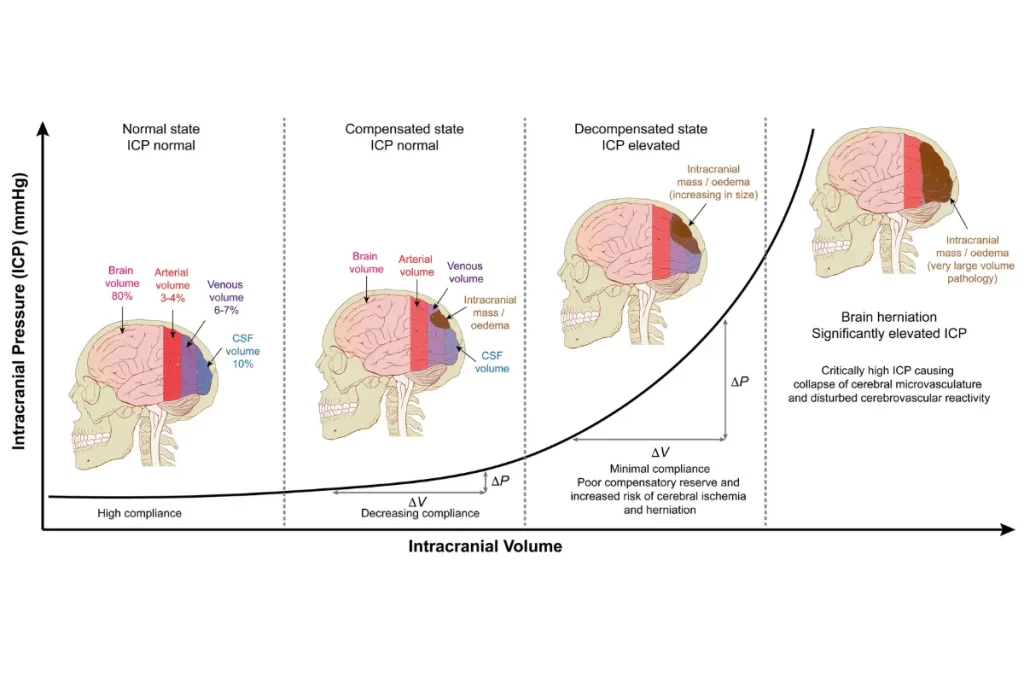Intracranial pressure (ICP) and head injuries are vitally important topics for medical study. Their consequences range from short-term issues to long-term harm or even demise if left untreated. However, there is a good deal of misinformation about them that needs to be dispelled since these are life saving topics. This article is intended to supply some facts to give you a better comprehension of head injuries and ICP, with the goal of erasing commonly lodged misunderstandings.
Myth 1: ICP can be easily diagnosed with a simple test
One of the most pervasive myths regarding ICP is that it can be easily diagnosed through a simple test. However, there is no easy or non-invasive test available to determine ICP. The only reliable methods of diagnosing ICP are invasive procedures, such as direct measurements using a catheter implanted into the brain or lumbar punctures.
Direct measurement of ICP using a catheter implanted into the brain is typically performed in critically ill patients who require continuous monitoring of ICP. During this procedure, a catheter is inserted through the skull and into the brain, where it can measure ICP directly.
A lumbar puncture is a procedure in which a needle is inserted into the lower back to measure the pressure within the spinal canal and the brain. This procedure can be used to diagnose conditions such as meningitis, brain tumors, or increased ICP.
It’s important to note that both of these procedures carry associated hazards and complications and are only carried out in extreme circumstances or as an emergency measure.
There are no non-invasive tests available to determine ICP. While some tests, such as head CT scans, MRI, or ultrasound, can provide images of the brain and detect certain conditions that can increase ICP, they do not directly measure ICP.
Myth 2: ICP is always a result of head injury
The idea that head injuries are only significant if there is obvious damage to the head, such as a cut or bruise, is another widespread myth. In reality, even if there is no visible damage, a head injury can still be quite serious. Some head injuries, like concussions, may not result in obvious physical harm, but they can still have detrimental effects on the body and brain. It’s possible that the effects of a head injury may not become apparent for several hours or even days after the accident has occurred.
While head injury can certainly lead to increased ICP, it is not the only cause. Other factors such as age, genetics, and medical conditions can also contribute to increased ICP. Some other causes of increased ICP include: traumatic brain injury, brain tumors, meningitis, hemorrhage (bleeding in the brain), hydrocephalus (a buildup of fluid in the brain), stroke and large ischemic stroke.
In some cases, elevated ICP can occur without any obvious cause, and it can lead to serious complications such as brain herniation, which can cause permanent brain damage or even death. Therefore, it’s important to be aware of the potential causes of elevated ICP and to seek prompt medical attention if you experience symptoms such as a headache, nausea, confusion, vomiting, changes in vision or loss of consciousness. as these may indicate increased ICP or another underlying medical condition.
Myth 3: Only severe head trauma can result in increased ICP
Another prevalent myth is that only severe head traumas can result in increased ICP. This is not true. Any type of head injury, whether minor or severe, can cause an increase in ICP. Even minor head traumas can result in increased ICP, which, if left untreated, can have fatal consequences. It’s important to seek medical attention even for mild head injuries to lower the risk of elevated ICP.
Myth 4: A headache indicates increased ICP
A headache is a common symptom of increased ICP, but elevated ICP is not the only cause of headaches. Stress, exhaustion, and eye strain are just a few of the other factors that can cause headaches. It is important to seek medical attention if you experience persistent or severe headaches, as this may indicate an underlying medical problem that requires diagnosis and treatment. A CT scan or MRI may be performed to determine whether increased ICP is the cause of the headache and to guide appropriate medical management.
Myth 5: Increased ICP inevitably results in brain injury
No, it is not always the case that increased intracranial pressure (ICP) will result in permanent brain injury. ICP is the pressure inside the contents of bony cranium, which contains the brain, blood, and cerebrospinal fluid. (You can read more about these intracranial compartments here: https://sensobrain.com/understanding-intracranial-pressure-exploring-the-monro-kellie-hypothesis/)
An elevated ICP can compress and damage the brain tissues, leading to brain injury. However, the relationship between elevated ICP and brain injury is complex and depends on several factors, such as the duration and magnitude of the elevated ICP, the age and overall health of the person, and the presence of other medical conditions.
ICP can be elevated without causing any brain injury, while in other cases, brain injury can occur without any increase in ICP. In some cases, timely and appropriate medical intervention can prevent brain injury even in the presence of elevated ICP. Therefore, it is important to seek prompt medical attention if you have suffered a head injury to lower the risk of complications from elevated ICP.
Myth 6: ICP is the same in all individuals
ICP refers to the pressure inside the contents of bony cranium, which contains the brain, blood, and cerebrospinal fluid. (You can read more about these intracranial compartments here: https://sensobrain.com/understanding-intracranial-pressure-exploring-the-monro-kellie-hypothesis/) ICP varies in the same person over the course of the day. ICP also varies from person to person, even in those with the same type of injury.
The normal range of ICP when lying flat is 6-25 centimeters of water (cm H2O). However, the exact value of ICP can vary depending on factors such as age, posture, and overall health. Additionally, the presence of a head injury, brain swelling, or other medical conditions can result in an increase in ICP, which can have serious consequences.
On the other hand, a decrease in ICP can also occur in certain medical conditions and be just as dangerous. ICP should be evaluated and monitored on a case-by-case basis, as it can vary greatly depending on the individual and their medical history.
Myth 7: Increased ICP can only be managed with medications
Even though they can be used to manage and treat elevated ICP in some cases, medications are not the only form of treatment. They are frequently combined with other approaches since each individual may need a different course of treatment due to their distinct medical histories and problems. In some circumstances, surgery may be required to lower ICP and alleviate the pressure on the brain. So, it is crucial to consult with a doctor in order to identify the best method for controlling and treating elevated ICP.
Myth 8: All head injuries result in long-term problems
While some head injuries can result in long-term problems, many people recover fully from head injuries with proper treatment. The extent of harm caused by a head injury varies depending on the severity of the injury, the location of the injury, and the individual’s unique medical history.
Some head injuries, like mild concussions, may result in short-term symptoms that eventually disappear on their own, while others may lead to more severe and long-lasting consequences. For example, severe head injuries that result in skull fractures, brain contusions, or internal bleeding can lead to long-term cognitive, physical, and psychological problems, such as memory loss, motor skill impairments, and mood changes.
It is crucial to seek prompt medical attention after a head injury, regardless of its severity, in order to lower the risk of long-term consequences. Your doctor can evaluate the extent of the injury and recommend appropriate treatment, including rest, pain management, and physical therapy, if necessary. In some cases, surgery may be necessary to treat life-threatening complications.



